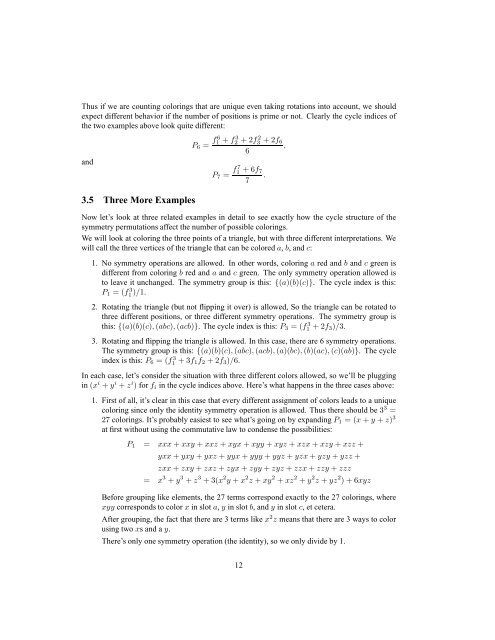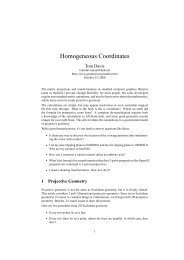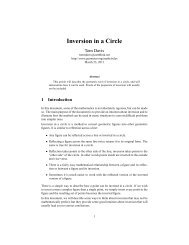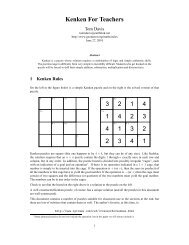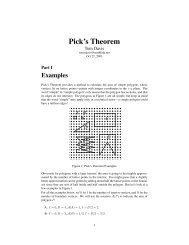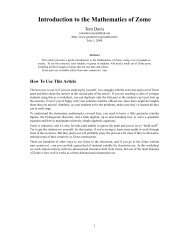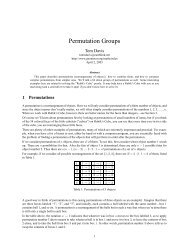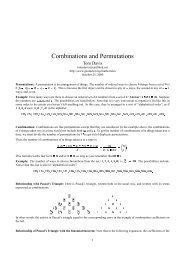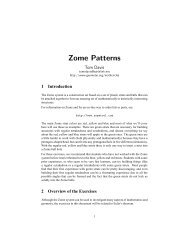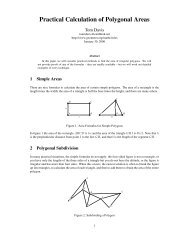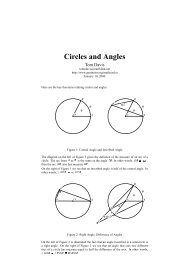P´olya's Counting Theory - Home Page -- Tom Davis
P´olya's Counting Theory - Home Page -- Tom Davis
P´olya's Counting Theory - Home Page -- Tom Davis
Create successful ePaper yourself
Turn your PDF publications into a flip-book with our unique Google optimized e-Paper software.
Thus if we are counting colorings that are unique even taking rotations into account, we should<br />
expect different behavior if the number of positions is prime or not. Clearly the cycle indices of<br />
the two examples above look quite different:<br />
and<br />
P 6 = f6 1 + f2 3 + 2f3 2 + 2f 6<br />
,<br />
6<br />
P 7 = f7 1 + 6f 7<br />
.<br />
7<br />
3.5 Three More Examples<br />
Now let’s look at three related examples in detail to see exactly how the cycle structure of the<br />
symmetry permutations affect the number of possible colorings.<br />
We will look at coloring the three points of a triangle, but with three different interpretations. We<br />
will call the three vertices of the triangle that can be colored a, b, and c:<br />
1. No symmetry operations are allowed. In other words, coloring a red and b and c green is<br />
different from coloring b red and a and c green. The only symmetry operation allowed is<br />
to leave it unchanged. The symmetry group is this: {(a)(b)(c)}. The cycle index is this:<br />
P 1 = (f 3 1 )/1.<br />
2. Rotating the triangle (but not flipping it over) is allowed, So the triangle can be rotated to<br />
three different positions, or three different symmetry operations. The symmetry group is<br />
this: {(a)(b)(c), (abc), (acb)}. The cycle index is this: P 3 = (f 3 1 + 2f 3 )/3.<br />
3. Rotating and flipping the triangle is allowed. In this case, there are 6 symmetry operations.<br />
The symmetry group is this: {(a)(b)(c), (abc), (acb), (a)(bc), (b)(ac), (c)(ab)}. The cycle<br />
index is this: P 6 = (f 3 1 + 3f 1f 2 + 2f 3 )/6.<br />
In each case, let’s consider the situation with three different colors allowed, so we’ll be plugging<br />
in (x i + y i + z i ) for f i in the cycle indices above. Here’s what happens in the three cases above:<br />
1. First of all, it’s clear in this case that every different assignment of colors leads to a unique<br />
coloring since only the identity symmetry operation is allowed. Thus there should be 3 3 =<br />
27 colorings. It’s probably easiest to see what’s going on by expanding P 1 = (x + y + z) 3<br />
at first without using the commutative law to condense the possibilities:<br />
P 1 = xxx + xxy + xxz + xyx + xyy + xyz + xzx + xzy + xzz +<br />
yxx + yxy + yxz + yyx + yyy + yyz + yzx + yzy + yzz +<br />
zxx + zxy + zxz + zyx + zyy + zyz + zzx + zzy + zzz<br />
= x 3 + y 3 + z 3 + 3(x 2 y + x 2 z + xy 2 + xz 2 + y 2 z + yz 2 ) + 6xyz<br />
Before grouping like elements, the 27 terms correspond exactly to the 27 colorings, where<br />
xyy corresponds to color x in slot a, y in slot b, and y in slot c, et cetera.<br />
After grouping, the fact that there are 3 terms like x 2 z means that there are 3 ways to color<br />
using two xs and a y.<br />
There’s only one symmetry operation (the identity), so we only divide by 1.<br />
12


